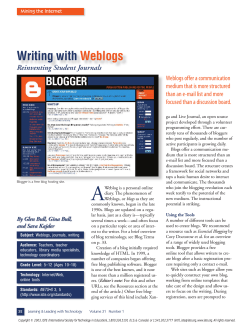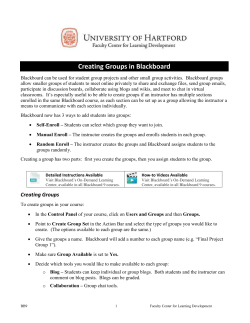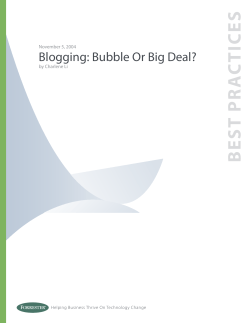
Social Software in Academia
G O O D I D E A S Social Software in Academia Still new on campus, social software tools can support students and staff beyond the classroom, reaching around the world for learning and communication By Todd Bryant C onsiderable buzz has appeared on the Internet over a group of new tools labeled social software. These tools can expand discussion beyond the classroom and provide new ways for students to collaborate and communicate within their class or around the world. Dickinson College has implemented two of the best-known tools, the wiki and the blog, in conjunction with voice over IP (VoIP) communication and social networking tools. Blogs A blog is probably the first tool that comes to mind when thinking about social software. The recent fame blogs have garnered in the media has led many teachers to consider their possible uses in the classroom, most commonly for students to create journals or express opinions on topics brought up in class. At Dickinson College we have used blogs to let students create journals of their volunteer, internship, or abroad activities. The blogs provide students with a way of reflecting on their own experiences while connecting with other students facing similar opportunities and challenges. Administrators use previously created blogs as introduction or orientation for new or prospective students. The first decision to make when setting up a blog involves hosting. If you want to test the waters with one or two classes and are unsure of future projects, you might not want to go through the trouble of setting up blogging software on your Web server. Instead, you could take advantage of a hosting service. Two of the largest are Blogger and LiveJournal. Hosted by Google, Blogger is fast, reliable, and well known. Many students, however, will be more familiar with LiveJournal, in some cases not realizing it is a blog. LiveJournal differentiates itself by allowing the author to set restrictions on who can see the blog. Users can invite friends and create groups organized by common interests or themes in their blogs. Another service, CALPER at Penn State, will host blogs for students and professors for free if the blogs involve foreign languages. The CALPER blogs are entirely Unicodebased, thereby avoiding potential issues that often occur with non-Latin character sets, and come with or without password protection. Number 2 2006 • E D U C A U S E Q U A R T E R LY 61 If your institution is ready to host its own blogs, various software packages will support the effort. Manila and Moveable Type have proprietary, out-ofthe-box software for Windows or Linux Web servers. If you prefer open source, WordPress will run on any server with PHP and MySQL installed. We had to customize WordPress to automate the process of adding users and their blogs to categories and subcategories, but the well-written code makes it simple to add features or modify methods. A wide variety of plug-ins can be added to WordPress without programming knowledge. Drupal is another open-source option worth serious consideration. Larger than WordPress, it provides more functionalities including wiki and content management in addition to blogs. Designed to support a large number of authors, it has built-in functions for groups and permissions. It runs on UNIX-based servers as well as Microsoft’s Internet Information Server on Windows. Implementing blogging software is fairly simple, and it requires less maintenance than a Web site. Once you have the software up and running, there are few technical issues or training requirements. Our training has so far consisted of a 10–15 minute introduction the first day of class for students on campus and some very basic instructions on the Web for students blogging abroad. I would, however, offer two points of caution. First, be sure the students understand what it means to publish to the World Wide Web, specifically the ramifications of writing opinions and experiences that can be read years later by potential employers, colleagues, and friends. Second, be prepared for exponential growth in the number of users. If one interested professor becomes 15 in a semester, the number of users can jump from 15 to 300 or more in a hurry. Without advanced planning to automate adding new users and blogs, the increase can overwhelm the IT staff. In the fall semester of 2005, eight Dickinson College courses—including foreign language, English, and digital photography courses—used blogs as a way for students to collaborate and continue discussion outside the classroom. 62 E D U C A U S E Q U A R T E R LY • Number 2 2006 One professor, Tullio Pagano, wanted to expose his students to a wider forum than the class, so he grouped the blogs of his students with those of a partner class overseas. The combined blog functioned as a meeting point for Italian classes here and English classes taught in a high school in Bologna, Italy. Students used the blog to post recordings of their language exchanges, submit assignments, and receive comments from their language partners on their writing and speaking. Wikis Like blogs, wikis are Web publishing tools. While blogs impose some structure through the chronological order of the postings, a wiki has no predefined structure. This makes wikis ideal for collaborative writing or group projects involving multimedia. Wikis can be used as a simpler alternative to a class Web site, for example. The global education department at Dickinson College uses wikis to allow students at the abroad centers to publish their newsletters online. The ease with which pages can be added and edited appeals to students, and the built-in tracking ability in the history aids in feedback and grading. For the IT staff it is significantly easier to train students on a wiki than on FrontPage or Dreamweaver. The syntax is simple and straightforward, and a graphical user interface (GUI) makes uploading simple over HTTP. In addition, because all pages are based on a single template and stylesheet, students generate pages that reflect good Web design. There are not nearly as many hosting services for wikis as for blogs. Wikispaces lets users experiment or get started. Socialtext will also host enterprise wikis for a fee. CALPER hosts wikis if a project is related to foreign language learning in any way. If your school is fairly serious about using a wiki, however, you’re probably better off hosting your own. Wikis are much harder to transfer from a host to your own server than blog posts because their structure is not as clearly defined. A large number of open-source options for wikis are available if you have a Web server, most of them written in PHP with MySQL. MediaWiki is probably the most well known because of Wikipedia. As a result, most users are familiar with the functions and layout. Compared to other wikis, MediaWiki is also fairly aesthetically pleasing, though simple, and has an easily customized side menu and stylesheet. If you want your own wiki but don’t want to install wiki software, TiddlyWiki provides an interesting alternative. It functions as a wiki, but everything is written in client-side JavaScript. The authors then save and upload their entries to any Web server. It involves no server-side installation or configuration. Of course, this means the authors, usually students, will need accounts and access to the Web server to upload their files, and they will also need to learn how to do this. Still, this approach can be advantageous depending on the resources available. Voice Over IP The quality and reliability of VoIP technology has increased remarkably over the past few years. The line is blurring between what used to be two separate utilities, instant messaging vendors (IChat, AOL, MSN Messenger) and VoIP providers such as Vonage. One of the applications doing much of the blurring is Skype, a VoIP program developed by the creators of Kazaa that offers free voice connections to any computer running Skype. Calling is also available to any phone around the world (for a fee, generally two cents per minute). Skype users can also text chat and send files between computers running Mac, Linux, and Windows. Since users can log in from any computer and still keep the same account, they’re not tied to a single location. Our IT staff uses Skype to communicate, especially with the desktop support staff, because they’re always moving from one location to the next. The fact that Skype is free opens up some uses that might not have been considered. For example, language exchanges between large groups of students on an individual basis and according to their own schedules are now realistic. As a result, Skype has become a centerpiece of our courses in Italian, Japanese, Arabic, and German. Students communicate with language partners either during class or as a homework assignment, with little or no technical support. They can record these conversations as MP3 files and hand them in to their professors. Of course, you still need to consider the potential obstacles. The VoIP connection is still not quite as reliable as the telephone, for example. If you will be communicating frequently with someone and are considering a VoIP application, you might want to try a trace route to check the speed and packet loss. Bandwidth can be an issue as well. Skype, for example, works quite well at 56 kilobits per second; however, if the bandwidth is available, it will use up to 300 Kbps in order to produce a very high quality of sound. For most U.S. universities and colleges, providing 300 Kbps for Skype may not be prohibitive depending on the number of connections, though private locations or schools and universities in other countries often have less available bandwidth. This becomes important if you want to contact language classes in high schools in Europe, as we do, using 15 simultaneous connections. You should then assess the bandwidth of the European schools. If they have one or multiple DSL connections, it is advisable to restrict the bandwidth available for the VoIP application. Otherwise, the early connections will connect at 300 Kbps, using up the available bandwidth, and the other connections will have poor quality or be unable to connect at all. Finally, if you’re trying to contact a new user without success, have them check their sound settings. They can do this by conducting a simple record and playback from their headset or using Skype’s test call option. Complete this simple check before you launch into an extensive probe of the network structures and firewalls involved. Odds are high the problem has a simple solution. Social Bookmarking Social bookmarking with tools such as Delicious and Furl lets users save Web addresses under their accounts online and tag these sites with keywords to organize them and make them search- Some emerging trends in social software are worth keeping an eye on able. This kind of bookmarking is popular among people who work from different computers and want to have their bookmarks readily available. It’s the social aspect of bookmarking that is of interest to us as educators, however. In addition to browsing your own bookmarks, you can also browse the bookmarks of others, either by looking at the bookmarks of those marked “friends” or by browsing the sites of those who have bookmarked similar or identical sites. Ted Perlmutter at the College of William and Mary used Delicious to have his students share and comment on readings they had found for his government course on the politics of immigration.1 Using tags agreed upon by the class and the description field, students can create their own research bank of related sites. Social Networking Social networking has been around for a while, but it has been generally ignored within academia for two reasons: all of the sites were hosted, and the well-known sites were not recognized for their academic discussions. The ability to create connections between people without regard to physical space offers some tremendous opportunities, however, if you know where to look. For example, Mixi, a Japanese site, provides the perfect opportunity for students of Japanese to interact with Japanese culture by reading profiles and blogs, joining groups, and speaking with native Japanese speakers. If you want to introduce your own environment to students, Pennster provides a useful model. It is part of the orientation to the University of Penn- sylvania. You no longer need to design your own software from scratch, either. An open-source application called Elgg combines blogging, tagging, and community functions of a social networking site with the stated goal of creating a learning landscape. Elgg also runs on PHP and MySQL. We have it running on a Mac OSX machine. We plan to create a site populated with students from our college and those of our partner universities with the idea of creating a virtual community that can function as an orientation and introduction to students studying abroad. Elgg is still very new, so we encountered some hurdles during the installation. Modification of the code was more difficult than for our wiki and blog software. Nonetheless, Elgg functioned without problems through preliminary testing, and we began inviting users in Bremen, Germany, and Malaga, Spain, in October 2005. Coming Next Some emerging trends in social software are worth keeping an eye on. The first is the addition of geographic information system (GIS) data that allows the social software sites to introduce an aspect of physical space. Plazes, for example, is a social networking site that adds another dimension by marking the GIS location of each user when they post and asking them to provide a picture and other information. This could expand the possibilities for education in social networking sites tremendously. Imagine, for example, instructing each student in a German class to explore a small part of Berlin. Students can peruse pictures and information about each public building, restaurant, bookstore, and other feature in their assigned areas as they move along the street. Furthermore, users can speak with people attached to these places, such as the owner of a bookstore or a frequent diner at a local restaurant. Before they leave home, students heading abroad can begin exploring the area surrounding the place where they will be living and the people who have provided the information. It’s not hard to see how the idea of physical space is tied to the growing Number 2 2006 • E D U C A U S E Q U A R T E R LY 63 Social Networking Resources Blogs WordPress: <http://wordpress.org> Blogger: <http://www.blogger.com> LiveJournal: <http://www.livejournal.com> Typepad: <http://www.typepad.com> Manila and Radio Userland: <http://www.userland.com/ weblogSolutions> Moveable Type: <http://www.sixapart.com/movabletype> Wikis WikiSpaces: <http://www.wikispaces.org> MediaWiki: <http://www.mediawiki.org/wiki/Main_Page> PHPWiki: <http://phpwiki.sourceforge.net> UseModWiki: <http://www.usemod.com/cgi-bin/wiki.pl> Twiki: <http://twiki.org> Messengers Skype: <http://www.skype.com> MSN: <http://messenger.msn.com> IChat: <http://www.apple.com/macosx/features/ichat/> AOL: <http://www.aim.com/> Yahoo: <http://messenger.yahoo.com/> IRC: <http://www.irc.org/> Gaim: <http://gaim.sourceforge.net/> Mixxer (language exchanges): <http://langtech.dickinson .edu/globalclass/index.aspx> Blogs Barbara Ganley’s blogs: <http://mt. middlebury.edu/ middblogs/ganley/bgblogging/> Barbara Ganley’s study abroad blogs: <http://mt.middlebury .edu/midd blogs/ganley/bloggingtheworld/> Jushua Kupetz’s Dismodern Body class: <http://itech .dickinson.edu/blog/index.php?cat=8> Professor Pagano’s third-semester Italian class: <http://itech .dickinson.edu/blog/index.php?cat=243> Wikis Mark Phillipson’s Romantic Audience Project: <http://ssad .bowdoin.edu:8668/space/snipsnap-index> Dickinson Study Abroad wiki: <http://itech.dickinson.edu/ wiki/index.php/DickinsonAbroad> Wikipedia list of university wikis: <http://universitywikinodewiki.wikicities.com/wiki/University-wikis> Social Bookmarking College of William and Mary Politics of Immigration course site: <http://www.prior-art.net/de.licio.us.htm> Social Bookmarking Further Information Delicious: <http://del.icio.us/> Furl: <http://www.furl.net/> Wikipedia: <http://www.wikipedia.org> NITLE blog: <http://apps.nitle.org/blog/index.php> Technorati: <http://www.technorati.com/> Many to Many: <http://www.corante.com/many/> Thesocialsoftwareweblog: <http://socialsoftware.weblogsinc .com/> NEATJ 2005 Proceedings, use of Mixi and Skype in Japanese language Instruction: <http://brown.edu/Departments/ East_Asian_Studies/Akiko%20Meguro.doc> Hybrids/Social Networking Elgg: <http://elgg.net/> Examples in Education Social Networking Pennster: <http://www.rescomp.upenn.edu/pennster/> use of mobile devices. Mobile blogging, or moblogging, is popular not only because it allows people to blog from anywhere but also because where the blogger is posting from can be relevant as well. Bloggers writing about natural disasters, geology, or political protests can now post from anywhere and mark their location, which can then be used by readers to view satellite photos of the area from Google maps or Microsoft’s new service, TerraServer. Most of the sites listed here offer RSS feeds or API interfaces that allow other 64 E D U C A U S E Q U A R T E R LY • Number 2 2006 programmers access to the information stored on them. Blogs provide pages that function as wikis, and both blogs and wikis provide plug-ins that let users post pictures stored on Flickr. Podcasting has become part of our lexicon as more people post MP3 files to their blogs, and Skypecasting is becoming more popular as people post their conversations, interviews, and language exchanges to their blogs. Our opportunities to extend the classroom will certainly increase as these technologies continue to integrate and expand. e Endnote 1. Perlmutter gave a presentation on his use of Delicious at a NITLE-sponsored social software users’ group meeting January 11–13, 2006, at the College of Wooster in Ohio, and we spoke afterwards. See <http://www.nitle.org/index.php/nitle/ opportunities/connect/social_software_ users_group_collaboration_development> (accessed January 18, 2006). Todd Bryant (bryantt@dickinson.edu) is Language Program Administrator in Library and Information Services at Dickinson College in Carlisle, Pennsylvania.
© Copyright 2025





















